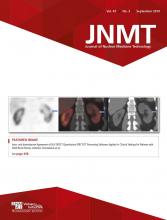TO THE EDITOR: I read “Pharmacology, Part 3A” in the December 2018 issue of the Journal of Nuclear Medicine Technology by Geoffrey M. Currie (1). I am concerned about one aspect of the discussion, specifically that of cholecystokinin, or its analog, sincalide (Kinevac; Bracco Diagnostics, Inc.), and its proper clinical use. The article states that the recommended dose is 0.02 μg and should be infused over 3–5 min. This method of infusion has been discredited, dating back to 1992 (2). Three-min infusions have been shown to have a very wide range in gallbladder ejection fraction response in healthy subjects and because of this, normal values could not be determined 2001 (3). In addition, 50% of these healthy subjects develop nausea and abdominal cramping. When the same healthy subjects received slower rates of infusions of 30–60 min, there was much less variability in response and normal values could be determined, although they were different for the 2 different infusion rates. Furthermore, no subjects had adverse symptoms.
These findings led to a multicenter investigation sponsored by the Gastrointestinal Council of the Society of Nuclear Medicine (now the General Nuclear Medicine Council of the Society of Nuclear Medicine and Molecular Imaging [SNMMI]) to determine the optimal method of cholecystokinin-cholescintigraphy infusion by comparing 15-, 30-, and 60-min infusions of sincalide in 60 healthy subjects at 4 institutions (4). The 15-min infusion showed the widest range of response, and similarly clinically useful normal values could not be determined. Some of these healthy subjects had nausea and or abdominal cramping. The 30-min infusion showed less variability; however, normal values could still not be calculated. The 60-min infusion showed the least variability in these healthy subjects, and normal values could be determined (≥38% gallbladder ejection fraction). No patients had adverse symptoms with the 30- or 60-min infusion methods.
These published data strongly suggest that patients given short infusions may have false-positive studies (low gallbladder ejection fractions but without disease) and end up erroneously going to surgery to have their gallbladder removed. The data also suggest that the adverse symptoms are caused by the method of infusion and unrelated to the presence or absence of disease.
The SNMMI Practice Guideline for Hepatobiliary Scintigraphy 4.0, published in 2010, recommends a slow infusion of sincalide (5). Subsequently an interdisciplinary panel consisting of 12 gastroenterologists, surgeons, and nuclear medicine physicians met and then published recommendations in 2011 to standardize sincalide infusion methodology at all centers and specifically recommended the slow infusion method of 0.02 μg over 60 min (6).
Footnotes
Published online Apr. 24, 2019.







